NotMutley - take 2
Posted
Full Member
Freelance 00 layout
Hi Barry,Maybe it would make it easier to follow and easier for me to explain if I start from the beginning and explain why I made the move into DCC and then in to railway computer software.
When I was forty one ( 1994) my dear old mum visited us from the UK and brought with her my train set that I had played with in the cellar of the family home right up to the time I discovered girls- when I was about 16.
My old train set, which was Marklin, was the worst for wear and not how I remembered it. After putting the track together on the kitchen floor my children - eldest then 10 encouraged me to build a permanent layout which I did but this time in OO and a British outline.
Fortunately we had the room and I quickly built the first of four layouts - far too much track and sidings that required lots of isolation and manual switches which in turn required a switchboard.
I didn't know anyone else that had a model railway layout so everything was built using model railway magazines as a guide. Then the internet made train forums accessible and overtime I stopped buying magazines and used the forums for reference, along with a growing number of reference sites.
By 1999 I was building my second railway and decided that although DCC would not replace my manual switchboard it would allow me to run multiple trains as it gave me control over the loco rather than rely just on the track.
For the next eight years I was happily "playing trains" but found that the complexity of my third layout, Not North Road(which was the first time I had given a layout a name) was creating problems and my switchboard building skills were being sorely tested. I had read on RMWeb about computer software and given that I had always had an interest in computers although I never got as far as computer programming, I decided to fork out for the best recommended software around at the time and bought Train Controller. (TC)
At first I used it only as a switchboard and manually controlled everything but over time and courtesy of the internet I "discovered" that I could "programme" TC to run locos automatically under certain conditions and my layout was big enough to allow the computer to control traffic on the mainline which I manually controlled locos in sidings etc - and the computer was clever enough that in the event that my loco ended up on the mainline the computer knew to stop locos running until the mainline was clear.
Since then I have slowly expanded the computers capabilities by putting in logic, such as the ones you have seen on this forum to enable the computer or me to control multiple functions such as "routes" where a click of a button on the screen automatically sets all the points to enable a loco to run from point A to B without the need for me to manually check each point along the way - even though I am manually controlling the loco. The computer is also able to identify if there any reasons why the route is not clear in which case it will not set the route no matter how many times I click the button.
Whilst I am "playing" in the fiddle yard the computer is capable of running trains totally automatically using its own logic - is the track clear, is the length of clear track long enough for this train ..etc or it can run pre- determined schedules which can be programmed by the user. I made this video in 2013 that shows the type of thing that can be done with an engine with a sound decoder and with ROCO uncouplers Shunting.
The internet forums have meant that even though there is no one that I know of in Sydney that uses TC I have been able to call on people like John and Max to assist in solving problems and finding new ways of doing things.
Trust this helps I can go into more detail especially on the way TC operates - the fundamental block occupancy, turnouts and signals if you would like.
best wishes
Posted
Full Member
I really get the idea of being a spectator of your own layout or being a driver whilst the computer plays signalman/controller. I regret that, at 60, and being a dyed-in-the-wool DC man, such fun will not be available to me so I will have to go on being driver, signalman, controller and the twit that fails to set the correct switch so that it either doesn't go or goes the wrong way. :oops:
We are perhaps blessed that the forums (more than the mags I believe) expose modellers to ALL of the options of control and offer support for those choosing to go down the less travelled paths.
Happy days
Shed dweller, Softie Southerner and Meglomaniac
Posted
Site staff

Ron
NCE DCC ; 00 scale UK outline.
NCE DCC ; 00 scale UK outline.
Posted
Full Member
Thanks for this Dave.
I really get the idea of being a spectator of your own layout or being a driver whilst the computer plays signalman/controller. I regret that, at 60, and being a dyed-in-the-wool DC man, such fun will not be available to me so I will have to go on being driver, signalman, controller and the twit that fails to set the correct switch so that it either doesn't go or goes the wrong way. :oops:
We are perhaps blessed that the forums (more than the mags I believe) expose modellers to ALL of the options of control and offer support for those choosing to go down the less travelled paths.
Happy days
There is hope for you yet Barry.
I didnt convert to DCC and RR&Co until I was 70……an old dog can still learn new tricks

Best wishes
John
Posted
Full Member
Nevertherless, what I said earlier still holds true - we are blessed to be able to share our own interests for the benefit of others without judgement. Long may it continue.
Me? I'm happy with DC, cab control and Classic FM instead of chuffs and whistles.
Keep up the (don't understand a word of it all) good work lads :thumbs :thumbs
Shed dweller, Softie Southerner and Meglomaniac
Posted
Site staff

I too was DC man as well Barry until my late 60's when in building a new layout that had a double track crossover like this
Me? I'm happy with DC, cab control and Classic FM instead of chuffs and whistles.
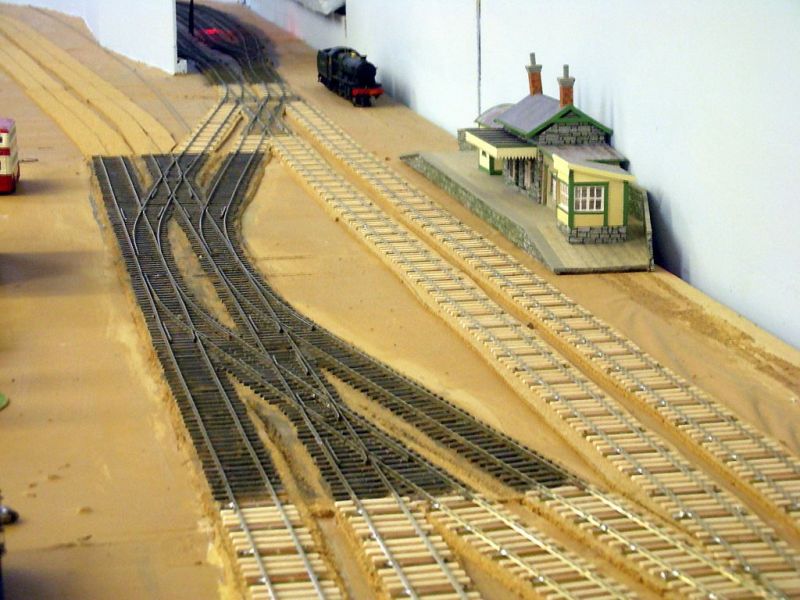
and in trying to work out the simplest operating method for cab control so any cab could be switched to any track and switched by any operator, got a bit much and having operated on DCC layouts, I went to the dark side. It does make life far easier for multiple operator layouts. I use DCC for loco control only though & no bells & whistles.
Ron
NCE DCC ; 00 scale UK outline.
NCE DCC ; 00 scale UK outline.
Posted
Inactive Member
I use DCC for loco control only, though & no bells & whistles.
You need a sound decoder for that, Sol.
Max
Port Elderley
Port Elderley
Posted
Site staff

[user=606]Sol[/user] wrote:I use DCC for loco control only, though & no bells & whistles.
You need a sound decoder for that, Sol.
I knew I should have written…
I use DCC for loco control only ( no bells or whistles needed) and for turnout/signal control, conventional DC.
Ron
NCE DCC ; 00 scale UK outline.
NCE DCC ; 00 scale UK outline.
Posted
Full Member
First target is the station area -
I am trying to recycle as much as the original NotMutley as possible and fortunately using Scalescenes makes this a relatively easy task ( emphasis on relatively) :roll:.
My platforms are cardboard covered timber and then covered in Scalescenes platform paper- one had to be heavily modified to fit the new curvature of the track on platform 3 whilst the other two platforms could be used as is.
First task was the rebuilt the footbridge. The available space for the platforms is less than on the original layout which means that there are curves at both ends of the station rather than straights so instead of placing the footbridge steps on the platform I extended the walls of the footbridge steps so that they could stand on their own at the end of the platforms.
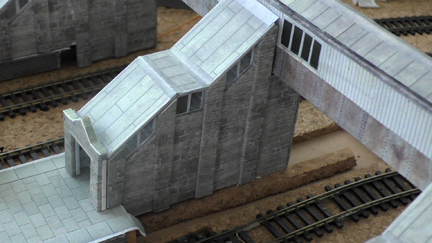
The picture above shows how the footbridge steps being narrower than the platform can sit where the platform would interfere with locos/carriages/wagons.
I had to do a similar modification to all three steps and then modify the overpass by putting in additional windows and extending it slightly
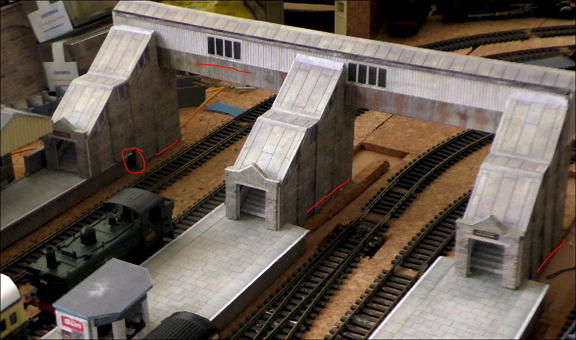
This photo shows the areas I have had to modify. I have been lazy and not modified the existing window on the right so that it sits in the centre between the two footbridges but I'm sure there is a prototype somewhere in the UK that is not symmetrical ;-) I am happy to take advice from club members as it is only about an hours work and the footbridge is not yet fixed in place…. this is because at the other end of the platforms I have a problem with the trains hitting the platforms as they approach from the curve so I have to remove and shorten all three and build platform ramps which will be made from cardboard ( Scalescenes to the rescue)
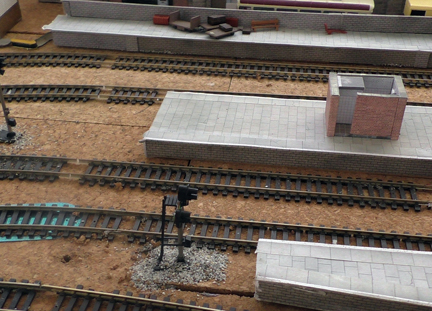
This photo shows the problem- especially the platform in the background. The platform in the foreground needs to shortened the least but needs to leave room for the operating signal - unless I replace it with a platform signal - again any thoughts ?
Posted
Full Member
Hi Dave
I meant to reply sooner.
Station looks very promising. I know what a pain it is to adapt buildings from previous layouts. You have made a super job of the bridge ……I was going to suggest moving the window but I see you have now done that.
I would put the signal on the platform……..that happened quite frequently on the prototype…….I would add tapered ramps to all the platforms although in extreme cases you could just add some steps for the station staff. No need for a barrow crossing. The luggage would be from platform to platform by the lift you cleverly concealed in the footbridge!
Cheers
John
Posted
Full Member
How did you know !The luggage would be from platform to platform by the lift you cleverly concealed in the footbridge!


Posted
Full Member
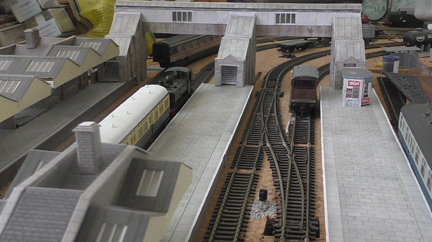
Platform ends modified
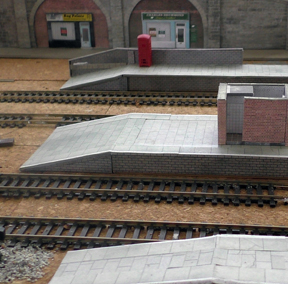
Not bad for a mornings work - now for the wiring for the station lamps etc……
Posted
Full Member
There are plenty of examples of signals on platforms so I would be saving some space and go for it. That leaves space for a lovely barrow crossing linking the ends of the ramps.
Shed dweller, Softie Southerner and Meglomaniac
Posted
Full Member
Thank you for your post and comments.
I took a screen shot of the Scalescenes ramp and then imported into photoshop and cropped it down so that the picture was the same height and length as the ramp - your eyes did not deceive you - when I adjusted the height to one inch the length was 4.271 inches. Way steeper than the current requirements. However, by the time I have added ballast etc ,which will reduce the height of the platform by more than the length of the ramp , then based on my cropping experiments, we should get down to a more respectable incline of 1:7.4 ( thanks to good old Pythagoras).
I am now working on the barrow crossing using large matchsticks ( thank goodness for BBQs!)
Based on photos I found on the internet, there are normally 5 wooden planks between the rails and I have found matches that are almost made to measure in terms of scale width.
As my platform ends are off set do you know how the crossing between the tracks should look? Should they go diagonally between the tracks or straight and snf then run parallel to the tracks?
Best wishes
 Last edit: by gdaysydney
Last edit: by gdaysydney
Posted
Full Member
A very quick look through some of my references suggests that the crossing would go straight across level with the longest platform. The ground at the end of the ramps for the shorter platforms would then be flattened to allow barrows etc to be wheeled.
If you search t'internet for plans/photos of Arnside Station, this is probably an extreme case.
The up platform sat in a triangular junction. At the tip of the platform, a barrow crossing was placed across the Barrow-Carnforth main line although the down platform was staggered and ended about 100ft further along the down line. At the end of the barrow crossing, there was a walkway about 100ft long running alongside the tracks until it met the bottom of the down platform ramp.
The same arrangement could be found at Birkenhead North although the walkway was only a few yards long.
I was going to add that the crossings were always put at the end of the platform most convenient for the station buildings but the more I looked at, the more that proved to be wrong. I even found examples where the crossings were laid adjoining staggered platform ends whilst the platforms at the other end aligned perfectly!! I guess each circumstance dictated its own solution - a perfect get-out for modellers.
Certainly on the LMS and LNER this appears to be how it was done - I don't have many pics/layout plans of GWR or SR stations.
Hope that helps
Barry
Shed dweller, Softie Southerner and Meglomaniac
Posted
Full Member
just bought some extra matchsticks !
Posted
Full Member
Plenty of work still to be done - Rome wasn't built in a day !!
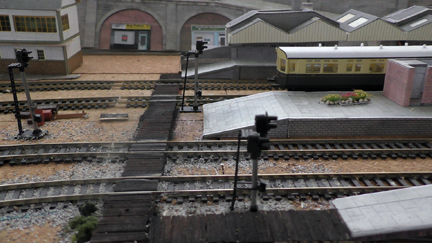
Posted
Full Member
the picture below shows the footbridge -
?

Posted
Full Member
Posted
Full Member
The layout is designed so that trains can enter the four lines on the left from either end although the line on the far left will have the majority of trains entering from the bottom left
Trust that helps
 Last edit: by gdaysydney
Last edit: by gdaysydney
1 guest and 0 members have just viewed this.

